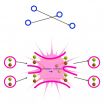Screening in pregnancy key to eliminating mother-to-child HIV transmission
2015-07-22
(Press-News.org) Canada has almost eliminated mother-to-child HIV transmission, known as vertical transmission, in recent years by ensuring that all women have the opportunity to be screened for HIV in pregnancy and that women with the disease receive treatment before giving birth.
In 2014, there was only one recorded transmission of the virus to babies born to women known to be living with HIV.
These findings were presented at the International AIDS Society 2015 conference in Vancouver by researchers from the Canadian Perinatal HIV Surveillance Program (CPHSP), a national group that has been collecting annual surveillance data about children born to women with HIV in Canada since 1990.
"Effectively, Canada has eliminated vertical transmission," said Dr. Jason Brophy, chair of the Canadian Pediatric & Perinatal AIDS Research Group (CPARG) which runs the CPHSP. CPARG has been active for 25 years in advocating for improved prevention of vertical HIV transmission and better care of children with HIV.
"The World Health Organization definition of elimination is less than two per cent transmission and that's where we are right now. But of course, we'd like to get to zero and I know that we can."
Women who receive combination antiretroviral therapy (cART) during pregnancy do not pass HIV on to their baby. Regular cART treatment is almost 100 per cent effective in preventing transmission when given for enough time to suppress the virus in the mother.
In three separate poster presentations about the surveillance program, CPHSP researchers examined the progress Canada has made in treating women with HIV, preventing the disease in infants as well as opportunities to improve care. They determined which populations are at greatest risk and how public health officials are working with those groups.
Since the 1990s, about half of women with HIV delivering babies in Canada were foreign born. Aboriginal women and women who use injection drugs were also at greater risk of having HIV in pregnancy and had consistently lower rates of treatment. Promising new findings in 2014 show that these two groups now have treatment rates comparable to other women.
"The database has allowed us to assess the national burden of HIV infection through vertical transmission throughout the HIV/AIDS epidemic and to identify the populations at greatest risk," said Joel Singer, professor in the School of Population and Public Health at UBC, who is presenting at IAS 2015. "The happy conclusion, at this point, is that vertical transmission in Canada is rare, and groups which were at excess risk are no longer so."
The researchers say this recent success stems largely from public health initiatives to ensure women in these high-risk populations are tested and receive the proper prenatal care. The researchers say the key to reaching the goal of zero transmission between mothers and infants is to engage hard-to-reach populations in health care and allow them to access prenatal care, HIV testing and cART treatment.
INFORMATION:
BACKGROUND: Poster presentations
The Canadian Perinatal HIV Surveillance Program (CPHSP): Program Description and Trends in Demographics, Treatment and Transmission
Joel Singer, a professor in the School of Population and Public Health at UBC, presented recent data from the program. In 2014, 97 per cent of all mothers received cART before birth. Notably, Aboriginal women and women who use injection drugs now have treatment rates comparable to other women.
Successes and Failures of Vertical HIV Transmission Prevention Efforts in Canada: Evidence from the Canadian Perinatal HIV Surveillance Program (CPHSP)
Ari Bitnun, a physician at SickKids and associate professor at the University of Toronto, examined cases of vertical transmission in Canada and identified missed opportunities for prevention. Of the 44 cases of vertical HIV transmission in Canada since 2005, 91 per cent occurred in women who got no cART or less than four weeks of cART before delivery. All 11 children diagnosed after three months of age were from provinces with opt-out prenatal HIV screening programs. The data strongly suggest that timely access to prenatal care and screening for HIV early in pregnancy, particularly for women from hard-to-reach populations, is essential if we are to eliminate vertical HIV transmission in Canada.
Geographic Origin Trends Among HIV+ Mothers and Children in Canada and Impact on Vertical HIV Transmission Rates
Jason Brophy, a physician at the Children's Hospital of Eastern Ontario (CHEO) and assistant professor at University of Ottawa, presented research showing that since 1990, half of mothers with HIV delivering in Canada are foreign born. In Quebec and Ontario, these women come most often from Haiti and East Africa, respectively. In Western Canada, Aboriginal women are the largest group of mothers with HIV. Over time, African-born women have become the least likely group to transmit infection to their babies.
The Canadian Perinatal HIV Surveillance Program is administered by the Canadian Pediatric AIDS Research Group (CPARG) and involves 22 HIV health centres and departments from all Canadian provinces and territories. Management of the program is coordinated in Vancouver, British Columbia by the Canadian Institutes of Health Research (CIHR) Canadian HIV Trials Network and support for the program is provided by the Public Health Agency of Canada (PHAC).
ELSE PRESS RELEASES FROM THIS DATE:
2015-07-22
SALT LAKE CITY- As part of a multi-institutional effort, researchers with Huntsman Cancer Institute at the University of Utah have found that multiple myeloma patients with a genetic variation in the gene FOPNL die on average 1-3 years sooner than patients without it. The finding was identified with a genetic mapping technique, genome wide association studies (GWAS), and verified in patient populations from North America and Europe. This was the first study to survey the entire human genome for genetic variation influencing survival, and included a total of 1,635 patients.
Published ...
2015-07-22
A test of the Mobile Bridge® Version 4.0 (MB4.0) over a real river demonstrated its viability for practical use. During the test, the bridge was set up without any foundation work, and a vehicle could easily travel across it. This was achieved safely with very few people and without any problems. The MB4.0 viability test results were presented at a symposium of the Japan Society of Civil Engineers (JSCE) on June 23, 2015, by Dr. Ichiro Ario, Assistant Professor at the Institute of Engineering, Hiroshima University.
Background of developing MB:
Natural disasters include ...
2015-07-22
A new theory says dark matter acts remarkably similar to subatomic particles known to science since the 1930s.
We owe a lot to dark matter - it is the thing keeping galaxies, stars, our solar system, and our bodies intact. Yet no one has been able to observe it, and it has often been regarded as a totally new exotic form of matter, such as a particle moving in extra dimensions of space or its quantum version, super-symmetry.
Now an international group of researchers has proposed a theory that dark matter is very similar to pions, which are responsible for binding atomic ...
2015-07-22
Bethesda, MD (July 22, 2015) -- Newborn children born with a mutation in the Plasmalemma Vesicle Associated Protein (PLVAP) gene develop severe protein losing enteropathy, according to a case study1 published in Cellular and Molecular Gastroenterology and Hepatology, the basic science journal of the American Gastroenterological Association. Protein losing enteropathy is a condition of the GI tract that results in loss of protein from the body, and often leads to severe abdominal swelling, malnutrition and early death in affected infants
The investigators utilized next-generation ...
2015-07-22
This news release is available in German.
New methods for modifying the genome are currently widely discussed: Using CRISPR/Cas for instance, scientists can remove parts of the genetic code of a gene, thereby knocking it out. Furthermore, there are ways to inhibit translation of a gene into a protein. Both methods have in common that they impede production of a protein and should therefore have comparable consequences for an organism. However, it has been shown that consequences can differ, after a gene is either knocked, out or only blocked. Scientist from the ...
2015-07-22
Levels of biomarkers in the blood of pregnant women can be used to predict which women are at risk of pre-eclampsia, finds a study published today (22 July) in BJOG: An International Journal of Obstetrics and Gynaecology (BJOG). ADMA and Hcy, both known to be raised in women with pre-eclampsia, are present in the blood in higher than normal concentrations a month before the onset of the condition.
Pre-eclampsia is a combination of raised blood pressure (hypertension) and protein in the urine (proteinuria). It is quite common, usually occurring after 20 weeks of pregnancy, ...
2015-07-22
Scientists at Lawson Health Research Institute have uncovered an important new target for ovarian cancer therapy. Contrary to current research this new study found that LKB1, a molecule that regulates the metabolism of many adult cells, is an important molecule in the cancer's promotion and survival.
Thousands of women are living with ovarian cancer in Canada. It is estimated that this year, 2,800 Canadian women will be newly diagnosed with this disease. Even though ovarian cancer continues to be one of the most serious women's cancers, there is a real lack in reliable ...
2015-07-22
Patients suffering from chronic cardiopulmonary diseases could soon have a solution to help them accurately monitor their health and warn doctors at the first sign of trouble.
By simply carrying their cellphone, equipped with the health-tracking app, MoveSense, developed by researchers at the University of Illinois at Urbana-Champaign, a patient's oxygen saturation level can be passively monitored with medical accuracy.
Oxygen saturation is a standard measure of health status, the single most important clinical measure. Unlike other methods of measuring oxygen saturation ...
2015-07-22
Roughly 20 to 30 percent of patients with hepatitis C virus (HCV) are also infected with human immunodeficiency virus type 1 (HIV). Both blood-borne viruses share the same modes of transmission, but many HCV medications currently have significant limitations due to adverse interactions with HIV treatments. Researchers at University of California, San Diego School of Medicine report a new combination that effectively treats HCV in patients co-infected with HIV.
The study, published online in the New England Journal of Medicine, found the combination of HCV drugs daclatasvir ...
2015-07-22
Smokers who successfully lowered their nicotine intake when they were switched to low-nicotine cigarettes were unable to curb their smoking habits in the long term, according to a study by researchers at UCSF and San Francisco General Hospital and Trauma Center.
The study, published online today (July 22) in the journal Addiction found that levels of cotinine, a derivative of nicotine measured in the blood, plummeted six months after smokers' regular cigarettes were replaced with low-nicotine ones. But levels started to rebound later into the study when smokers returned ...
LAST 30 PRESS RELEASES:
[Press-News.org] Screening in pregnancy key to eliminating mother-to-child HIV transmission



